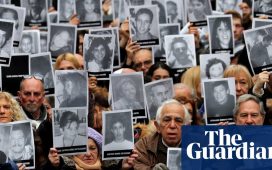Thirty-six years have passed but, at a cinema in New York this week, the memories came flooding back for Steve Pieters.
The Aids activist was attending the premiere of The Eyes of Tammy Faye, a film that includes a recreation of a seminal TV interview he gave to Christian televangelist Tammy Faye Bakker in 1985.
“It was a bit surreal to hear an actor saying the actual words I said to Tammy Faye all those years ago and to see Jessica Chastain as Tammy Faye interacting with Randy Havens as me,” Pieters, 69, says by phone. “It was just amazing and I love the way they used my interview as a pivotal point in the film.”
It was the raw emotional authenticity of the 24-minute interview that inspired Chastain to make a movie about Tammy Faye, who achieved stardom with her husband, Jim Bakker, through the PTL (Praise the Lord) network only to be brought down by financial and sex scandals.
The film, based on a 2000 documentary, portrays the young Tammy Faye and Jim (played by the British actor Andrew Garfield) as happy warriors for Christianity, injecting joy into an otherwise staid and punitive religion preached by Jerry Falwell Sr and Pat Robertson.
At its height The PTL Club, the couple’s flagship TV programme, was seen in 13m households. Appeals for donations from viewers helped swell their ministry, including Heritage USA, a Disney-style theme park and resort in South Carolina.
Early in their careers, the Bakkers created a puppet show for children, which caught Robertson’s eye and led to TV work. The movie conveys how Tammy Faye’s earnest, spontaneous and larger than life personality caught the public imagination. John Wigger, a history professor at the University of Missouri-Columbia, wrote the book PTL: The Rise and Fall of Jim and Tammy Faye Bakker’s Evangelical Empire. “A large part of her appeal on the show was that she was so open and unfiltered,” he says. “She said whatever was on her mind, no matter how inappropriate, and I think we’re just naturally drawn to people that we know are guileless and transparent and vulnerable. You instinctively trust them because wow, they’re going to tell you exactly what they’re thinking.”
The Bakkers’ radical empathy reached a zenith when Tammy Faye interviewed Pieters, an openly gay church pastor living with HIV. He had endured a near-death experience from an experimental drug only two weeks earlier, he recalls, but said yes to the conversation after being assured that it would broadcast live so it could not be edited.
“I agreed to the interview right away because I felt that it would be an opportunity for me to reach an audience I would never otherwise get to reach about God’s love for all people, especially LGBT people and people with Aids,” he says from Los Angeles.
“1985, when the interview happened, was a time when there was very little visibility of LGBT people. We were busy taking care of those of us who were dying and people were terrified of Aids and HIV because they didn’t believe the scientists about how it was transmitted, that it was actually difficult to catch, and so there was a lot of fear.”
The interview with Tammy Faye was conducted via satellite, not in person, even though Pieters was willing to travel and meet her in person. “I did a lot of interviews outdoors in an alley beside the Aids Project Los Angeles because camera crews wouldn’t work if I came into the studio. That was basically what happened at Heritage Village too.
“I learned many years later that the reason they decided to do a satellite interview with me rather than bring me to the studio was not because I was too sick to travel but they felt that, while Jim and Tammy would have been hospitable, their Heritage Village employees and staff and perhaps even the camera crew would not work if I came across and sat with her in the studio.”
Wigger spoke with dozens of former PTL employees for his book. He says: “Their brand of faith was just more open and accepting but then I think Tammy was her own version of that. So Jim would not have done that interview with Steve Pieters because he would have been worried about offending the base. He would have thought, ‘That’s a bridge too far, that’s not where I want to go.’ Tammy was unconcerned about those kinds of barriers and borders. To her it just didn’t seem to make sense that you couldn’t talk to someone who was in need.”
Homophobia was rife in the church. Many saw Aids as punishment from God while President Ronald Reagan remained silent on the epidemic for years. In this climate, Tammy Faye’s interview with Pieters was almost a revolutionary act.

“It was groundbreaking because it was the first time that an evangelical Christian had been affirming of a gay man living with Aids and it really rocked the conservative Christian community and kind of rocked the gay and lesbian community as well. I’ve had any number of people come up to me through the years and say that my interview with Tammy Faye saved their lives or helped them to realise they could be gay and Christian and it turned them around and made them realise they had to come out.”
The original interview, and the film dramatisation, show Tammy Faye displaying warmth and empathy towards Pieters, becoming tearful and expressing a wish that she could give him a hug.
Pieters remembers best “her love and compassion and her affirmation of me as a gay man with Aids. There was a point in the interview which is actually in the new movie where I said, ‘Jesus loves me just the way I am. Jesus loves the way I love.’ It really caught her short and she paused for a moment and collected herself and that moment said, ‘It’s so important that we as Christians embrace everybody because that’s the way with Jesus.’ It was a very emotional moment.”
But the interview drew a backlash from conservative hardliners in the church. Pieters continues: “She got a lot of trouble for it. I am told for Jerry Falwell that interview was the straw that broke the camel’s back and that’s when he decided he really had to do something about Jim and Tammy and bring them down, and that’s when he really started plotting on how to do that.
“It rocked her world because she got so much criticism for it I’m told that the next week she was required to do an interview with a Christian psychiatrist who claimed to convert gay people to heterosexuality and thereby help cure themselves of Aids. She apparently was reluctant to do that interview but she she decided she had to to appease the conservative Christians around her. Her husband, Jim Bakker, was supportive of her doing the interview with me, I have learned.”
What was it that allowed Tammy Faye to break from the conservative orthodoxy of the time and connect with Pieters. “From what I know of her story, she knew what it was like to be marginalised.
“She knew what it was like to be on the outside looking in and not feel like she was really accepted for who she was and so I think that that she really related to the LGBT population. She said a number of times that when PTL fell apart, or when it was brought down by Falwell and his cronies, that it was the LGBTQ community that that saved her life, that caught her and held her close and loved her back to life.”

Bakker misused ministry funds to pay a woman who accused him of sexually assaulting, an allegation he denied. He was convicted in 1989 of raising pledges with false promises while also steering millions to pay for the couple’s lavish lifestyle.
Tammy Faye, who filed for divorce while Bakker was behind bars, was never indicted.
“For the book, I interviewed the federal prosecutors who prosecuted Bakker and, at one point, I asked one of them why they didn’t prosecute Tammy Faye,” Wigger says. “This was a little tongue in cheek but he just laughed and he said we knew they would never tell her anything because she would just tell everyone else: she wouldn’t have kept any secrets so we knew she didn’t know any secrets.”
Her highly coiffed, heavily made-up persona was mocked and parodied on comedy shows such as Saturday Night Live. She died in 2007 at the age of 65, having remarried.
Pieters never met her in person but is a close friend of her son, Jay Bakker. “He was 10 at the time that I did the interview with her and he said that it changed his whole outlook on his mother and on on all of it. She began taking him and his sister to LGBT-affirming churches. pride parades, Aids hospices and hospitals and had them learn about people with Aids by interacting with them in the hospital.
“She saw that she had a ministry to the LGBTQ community and took great joy in it. She was the grand marshal of a pride parade at one point and she had all the drag queens and the gay people all singing, ‘Jesus loves me this I know / For the Bible tells me so’. She had them all singing along and I would have loved to have seen that.”





